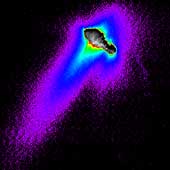|
COMETS EARTH JUPITER KUIPER BELT MARS MERCURY METEORITES NEPTUNE OORT CLOUD PLUTO SATURN SOLAR SYSTEM SPACE SUN URANUS VENUS ORDER PRINTS
PHOTO CATEGORIES SCIENCEVIEWS AMERICAN INDIAN AMPHIBIANS BIRDS BUGS FINE ART FOSSILS THE ISLANDS HISTORICAL PHOTOS MAMMALS OTHER PARKS PLANTS RELIGIOUS REPTILES SCIENCEVIEWS PRINTS
|
Related Documents
Download Options
Download Options
A composite of images from NASA's Deep Space 1 spacecraft shows features of comet Borrelly's nucleus, dust jets escaping the nucleus and the cloud-like "coma" of dust and gases surrounding the nucleus. False color is used to reveal details of the jets and coma. The images were taken when Deep Space 1 was about 4,800 kilometers (3,000 miles) from Borrelly during a Sept. 22, 2001, flyby. Borrelly's nucleus is about 8 kilometers (5 miles) from end to end, so the field of view is about 40 kilometers (25 miles) across. The Sun shines from the bottom of the image. The main dust jet, seen extending toward the bottom left, heads away from the comet in a direction that is about 30 degrees off the direction straight toward the Sun from the comet. The colors show about three orders of magnitude in the brightness of the dust jets and coma. Red indicates about one-tenth the brightness as the brightness of the nucleus, blue one-one-hundredth, purple one-one-thousandth. The red bumps near the nucleus indicate where the jet resolves into three distinct, narrow jets, which likely come from discrete source points on the surface. Deep Space 1 completed its primary mission testing ion propulsion and 11 other advanced, high-risk technologies in September 1999. NASA extended the mission, taking advantage of the ion propulsion and other systems to undertake this encounter with the comet. |
